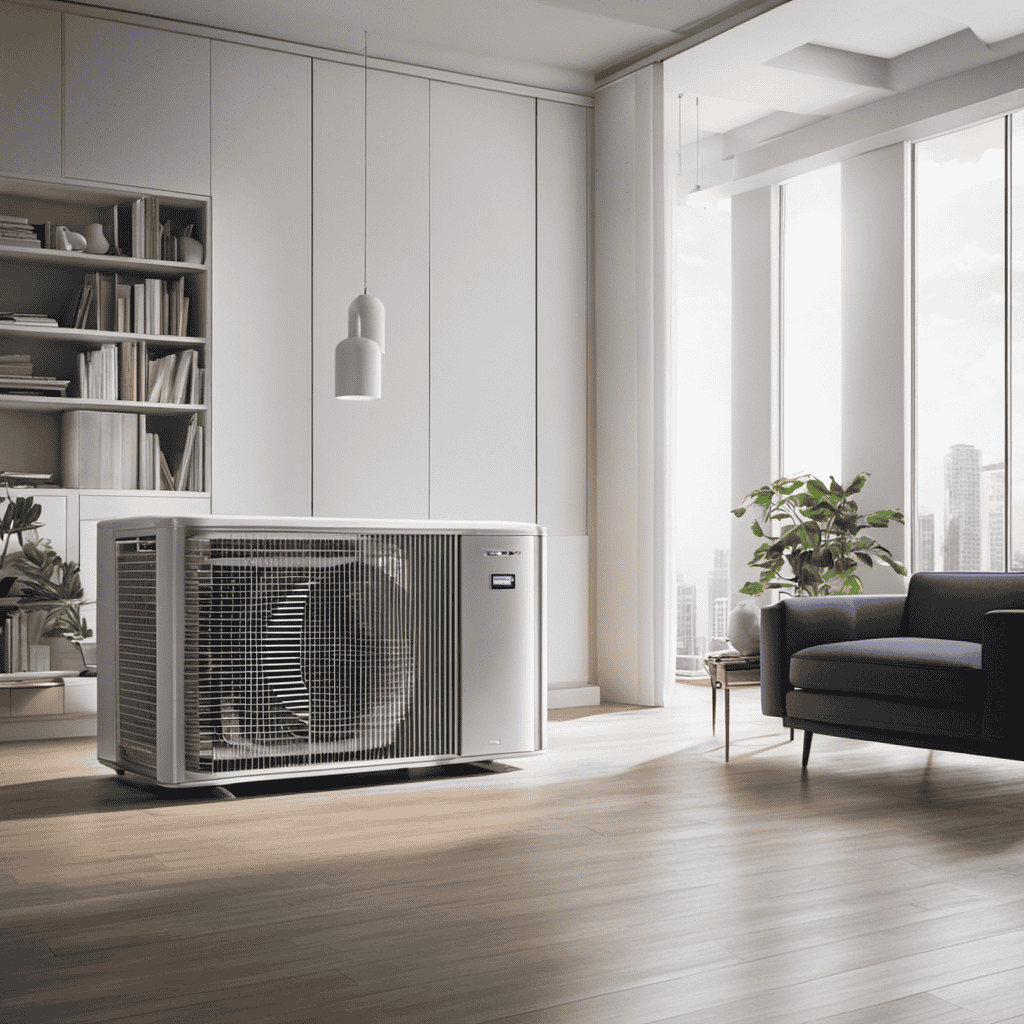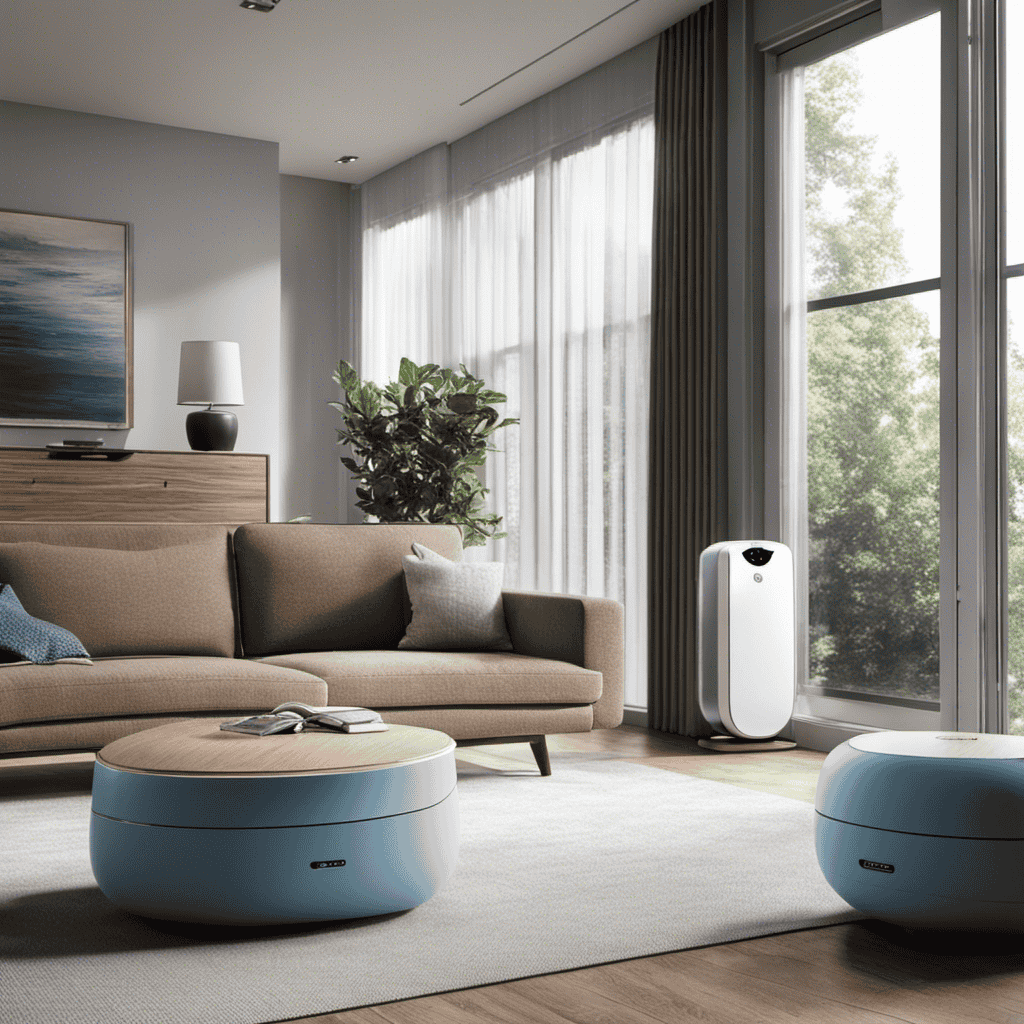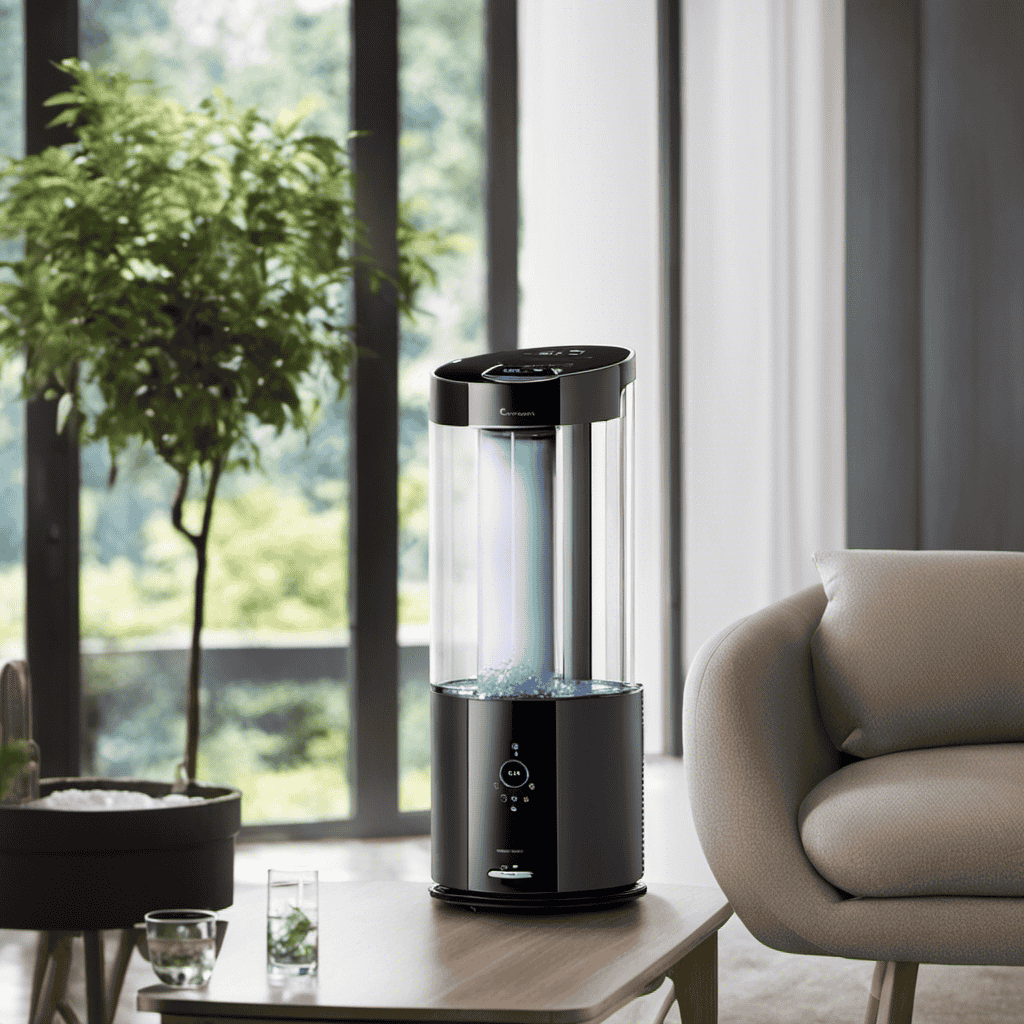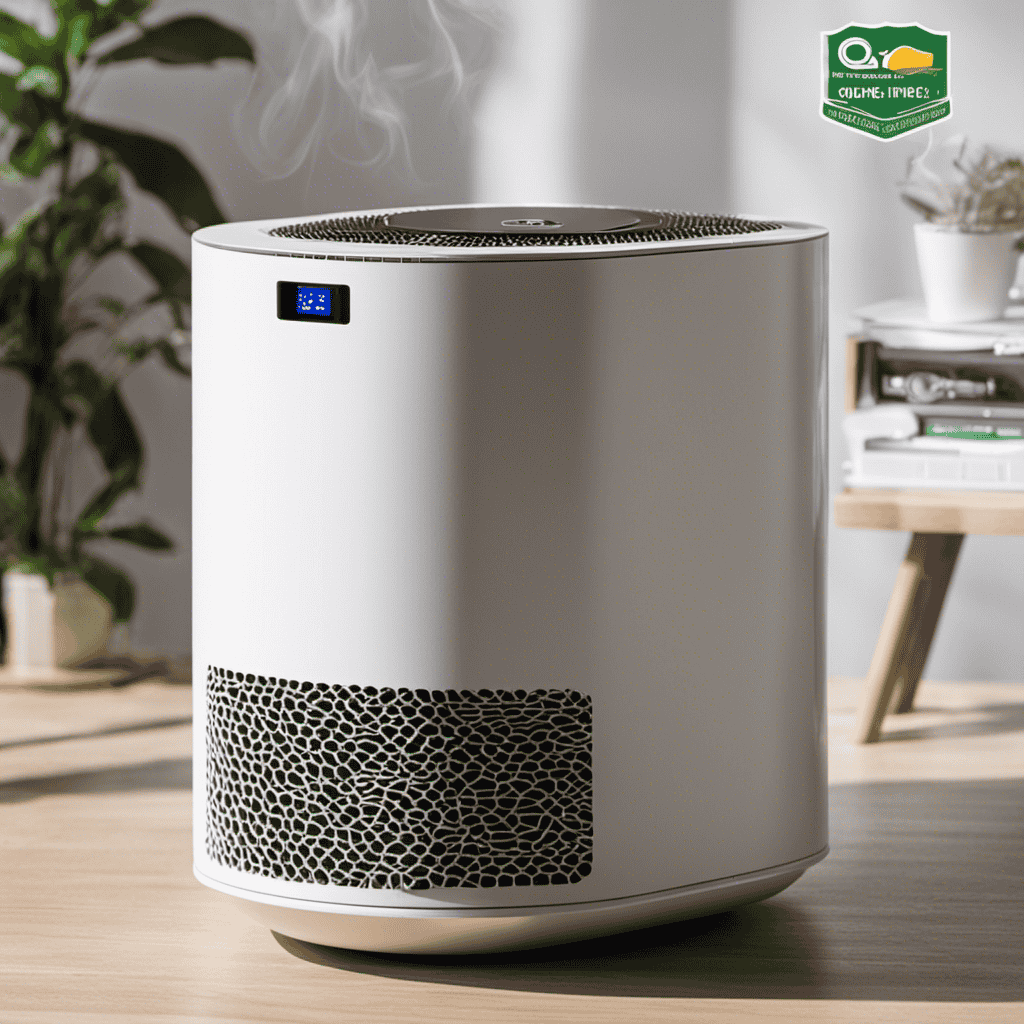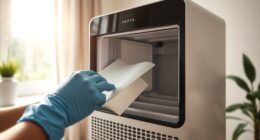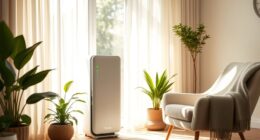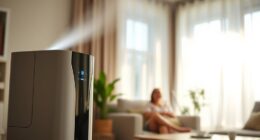As a homeowner, I have always been curious about how air purifiers function when connected to central units. The technology involved in enhancing indoor air quality and the importance of filters in this process is truly intriguing.
With central units, it’s crucial to understand how air flow and circulation come into play. In this article, we’ll delve into the basics of air purification, explore the inner workings of central units, and discuss the key features to look for in an air purifier.
So, let’s dive in and uncover the secrets of how air purifiers work on central units.
Key Takeaways
- Air purifiers on central units filter the air that flows through the HVAC system, removing contaminants such as dust, pollen, pet dander, and mold spores.
- The filtration process involves pre-filters, HEPA filters, and activated carbon filters.
- Regular maintenance, including filter replacement and duct cleaning, is essential for optimal performance.
- Air purification improves indoor air quality, reduces allergies, and promotes a healthier living environment.
The Basics of Air Purification
To understand the basics of air purification, you’ll need to know how air purifiers work on central units. Central air purifiers operate by filtering the air that flows through the HVAC system in your home. These units are designed to remove various contaminants from the air, such as dust, pollen, pet dander, and mold spores.
The understanding of the filtration process is crucial in comprehending how air purifiers work. The air passes through a series of filters, including pre-filters, HEPA filters, and activated carbon filters, which trap and eliminate different particles and odors. This process ensures that the air circulating in your home is clean and free from harmful pollutants.
Keeping the air clean is of utmost importance, as it helps improve indoor air quality, reduces allergies, and promotes a healthier living environment.
Understanding Central Units
Understanding how central units function can help you grasp the mechanics of air purifiers in these systems. Central units are the heart of the air purification system, responsible for circulating the air throughout the entire building. Here are some key points to consider when it comes to understanding central units:
-
Installation: Central units are typically installed in a centralized location, such as the basement or utility room, to ensure efficient air distribution.
-
Airflow: Central units use a network of ducts to distribute the purified air to different rooms, ensuring consistent air quality throughout the building.
-
Filtration: Central units are equipped with high-efficiency filters that capture airborne particles, allergens, and pollutants, improving indoor air quality.
-
Maintenance: Regular maintenance, such as replacing filters and cleaning ducts, is essential to ensure the optimal performance of central units.
-
Troubleshooting: Understanding common troubleshooting techniques, such as checking for clogged filters or duct obstructions, can help identify and resolve issues with central units.
By understanding the installation and troubleshooting techniques of central units, you can effectively ensure the proper functioning of air purifiers in these systems.
Now, let’s delve into how air purifiers improve indoor air quality.
How Air Purifiers Improve Indoor Air Quality
Air purifiers can significantly enhance the quality of indoor air by removing pollutants and allergens. These devices work by using various technologies to capture and eliminate harmful particles from the air. Some of the benefits of using air purifiers include reducing symptoms of allergies, asthma, and other respiratory conditions. Additionally, they can help eliminate unpleasant odors and improve overall air freshness. Air purifiers are especially effective in combating indoor air pollution, which can be caused by factors such as dust, pet dander, mold spores, and volatile organic compounds (VOCs) from household products. By removing these contaminants, air purifiers create a healthier and more comfortable living environment.
| Air Purifier Benefits | Indoor Air Pollution |
|---|---|
| Reduces Allergies | Dust |
| Relieves Asthma | Pet Dander |
| Eliminates Odors | Mold Spores |
| Improves Air Freshness | VOCs |
| Creates Healthy Environment |
Investing in an air purifier can provide long-term health benefits and improve the overall quality of life for individuals and families.
The Role of Filters in Air Purification
When it comes to air purification, understanding the different filter types and their effectiveness is crucial. Filters play a vital role in trapping and removing pollutants from the air, ensuring cleaner and healthier indoor environments.
Regular filter maintenance and replacement are also essential to maintain the efficiency and performance of air purifiers. Clogged or worn-out filters can compromise their effectiveness.
Filter Types and Effectiveness
To effectively filter the air in your central unit, you should consider the different types of filters and their effectiveness. There are several options available, each with its own benefits and drawbacks.
Here are some key factors to consider when choosing the right filter for your central unit:
-
HEPA Filters: These high-efficiency filters are capable of removing 99.97% of particles as small as 0.3 microns, making them highly effective in improving indoor air quality.
-
Electrostatic Filters: These filters use an electrostatic charge to attract and capture particles, including allergens and dust, improving air quality.
-
Carbon Filters: These filters are effective at removing odors, gases, and chemicals from the air, making them ideal for households with pets or smokers.
-
Pleated Filters: These filters have a larger surface area and can capture more particles, providing better filtration and improved air quality.
-
Washable Filters: These filters can be reused after washing, making them a cost-effective option for filter maintenance.
Considering these factors will help you choose the right filter for your central unit, ensuring cleaner and healthier air in your home.
Maintenance and Replacement Frequency
Regularly changing your filters is crucial for maintaining optimal performance and ensuring that your indoor air quality remains clean and healthy. To establish a proper replacement schedule, it is important to consider the type of filter being used, the air quality in your area, and the manufacturer’s recommendations.
Most filters need to be replaced every 3-6 months, but some high-efficiency filters may last up to a year. However, it is essential to check the filter regularly and replace it when it appears dirty or clogged.
Cleaning techniques vary depending on the filter type. Disposable filters should be replaced, while washable filters can be cleaned with water and mild detergent. Remember to let the filter dry completely before reinstalling.
Regular maintenance and adherence to the recommended replacement schedule will ensure that your air purifier continues to function effectively, providing you with clean and healthy indoor air.
Air Flow and Circulation in Central Units
Proper airflow is crucial in maintaining optimal performance and efficiency in central air units. It ensures that the air is evenly distributed throughout the space, preventing hot or cold spots.
Efficient circulation techniques, such as using adjustable vents and strategically placed fans, can further enhance the airflow and improve the overall comfort and air quality in the environment.
Importance of Proper Airflow
Having good airflow is crucial for the proper functioning of an air purifier on central units. Without proper ventilation, the air purifier will not be able to effectively filter and clean the air in your home. Here are five reasons why proper airflow is important for air purifiers on central units:
- Ensures efficient air circulation throughout the entire house.
- Prevents stale air from accumulating in certain areas.
- Helps maintain a consistent temperature and humidity level.
- Reduces the risk of mold and mildew growth.
- Improves overall air quality control by removing pollutants and allergens.
By ensuring proper airflow, you can maximize the performance of your air purifier and enjoy clean, fresh air throughout your home.
Remember to regularly clean and maintain your central unit to optimize its effectiveness in maintaining proper ventilation and air quality control.
Efficient Circulation Techniques
To improve the circulation of air in your home, try using fans strategically placed throughout different rooms. Efficient ventilation methods and airflow optimization are crucial for maintaining a comfortable and healthy indoor environment.
When it comes to optimizing airflow, placing fans in key locations can make a significant difference. Start by identifying areas in your home where air tends to stagnate, such as corners or rooms with limited windows. By positioning a fan in these spots, you can promote air movement and prevent the buildup of stagnant air.
Additionally, consider placing fans near windows or doors to create cross-ventilation. This will allow fresh air to enter and stale air to exit, effectively improving overall air circulation. Remember to adjust the fan speed and direction to maximize airflow and create a pleasant indoor environment.
Different Types of Air Purifiers for Central Units
There are various types of air purifiers available for central units. When it comes to central unit compatibility, it’s important to choose an air purifier that is specifically designed to work with your central heating and cooling system.
The installation process of these air purifiers usually involves connecting the unit to the ductwork of your central unit.
Here are some key types of air purifiers for central units:
- Electronic air cleaners: These use an electronic charge to remove particles from the air.
- UV germicidal lights: These use ultraviolet light to kill bacteria and viruses.
- HEPA filters: These are highly effective at capturing small particles like pollen and pet dander.
- Activated carbon filters: These are great for removing odors and chemicals from the air.
- Ozone generators: These release ozone to destroy pollutants, but they should be used with caution.
Overall, choosing the right air purifier for your central unit and following the correct installation process is essential for improving indoor air quality.
Key Features to Look for in an Air Purifier
When looking for an air purifier, it’s important to consider the filtration technologies it uses. HEPA filters are highly effective in removing airborne particles such as dust, pollen, and pet dander.
Additionally, activated carbon filters are excellent at absorbing odors and chemicals.
Another crucial factor to consider is the suitable room size range of the air purifier. It’s essential to choose a model that can effectively clean the air in the specific size of the room you plan to use it in.
Important Filtration Technologies
You should consider using air purifiers with HEPA filters for your central units. These filters are highly effective in removing airborne particles such as dust, pet dander, pollen, and mold spores. With advanced filtration techniques, HEPA filters can capture particles as small as 0.3 microns, ensuring clean and healthy air in your home.
To maintain the performance of your air purifier, regular maintenance is essential. Here are some key maintenance tips:
- Replace the HEPA filter as recommended by the manufacturer.
- Clean the pre-filter regularly to remove larger particles and prolong the life of the HEPA filter.
- Vacuum the exterior of the air purifier to remove dust and debris.
- Keep the unit away from obstructions to ensure proper airflow.
- Monitor the air quality indicators and adjust the settings accordingly.
Suitable Room Size Range
To determine the suitable room size for your air purifier, consider factors like square footage and the CADR rating. Room size limitations can affect the effectiveness of your air purifier in providing clean and fresh air. It is important to choose an air purifier that is designed for the size of the room you plan to use it in, to ensure optimal performance.
| Room Size | CADR Rating |
|---|---|
| Small | 100-200 |
| Medium | 200-400 |
| Large | 400-800 |
| Extra Large | 800-1600 |
| Open Concept | 1600+ |
Maintenance Tips for Air Purifiers in Central Units
Make sure you regularly clean or replace the filters in your air purifier for optimal performance in your central unit. Proper maintenance techniques are crucial to ensure that your air purifier functions efficiently and effectively.
Here are some troubleshooting tips to help you keep your air purifier in top shape:
- Check and clean the pre-filter regularly to remove larger particles and prolong the life of the main filter.
- Clean or replace the main filter according to the manufacturer’s instructions to maintain its filtering capabilities.
- Clean the air intake vents and exhaust vents to prevent dust and debris buildup.
- Inspect the fan blades for any dirt or debris and clean them if necessary.
- Regularly monitor the air purifier’s performance and contact customer support if you notice any unusual noises or reduced airflow.
Common Issues With Air Purifiers and Central Units
Now that we have covered some maintenance tips for air purifiers in central units, let’s discuss some common issues that you may encounter with these devices.
Although air purifiers are designed to improve indoor air quality, they can sometimes experience problems that affect their performance. One common issue is a decrease in air flow, which can be caused by a clogged filter or a malfunctioning fan. To troubleshoot this, check the filter and clean or replace it if necessary.
Another issue is the development of strange odors, which can be caused by a dirty filter or an accumulation of pollutants. Cleaning or replacing the filter should help resolve this problem.
The Benefits of Using an Air Purifier in a Central Unit System
If you’re concerned about the quality of your indoor air, using an air purifier in your central unit system can greatly benefit you. Not only does it improve the air you breathe, but it also enhances the overall performance of your central unit.
Here are the benefits of using an air purifier in a central unit system:
-
Improved air quality: An air purifier removes harmful pollutants and allergens from the air, making it cleaner and healthier to breathe.
-
Central unit compatibility: Air purifiers are designed to work seamlessly with central units, ensuring optimal performance and maximum air purification.
-
Energy efficiency: By filtering the air before it reaches the central unit, an air purifier helps reduce strain on the system, resulting in lower energy consumption and increased efficiency.
-
Long-lasting filters: Air purifiers have durable filters that can last for months, saving you money on frequent replacements.
-
Convenience: Once installed, an air purifier in your central unit system operates silently and automatically, requiring minimal maintenance.
With these benefits, using an air purifier in your central unit system is a smart choice for improving indoor air quality and energy efficiency.
Frequently Asked Questions
Can an Air Purifier Be Used in a Central Unit if the Unit Does Not Have a Built-In Air Filtration System?
Yes, an air purifier can be used in a central unit without a built-in air filtration system. It provides cleaner air by removing pollutants and allergens, which improves indoor air quality and reduces the need for extensive air purifier maintenance.
How Often Should the Filters in an Air Purifier for Central Units Be Replaced?
When it comes to replacing filters in air purifiers for central units, it’s important to consider the cost and benefits. Regular replacement ensures optimal performance and clean air throughout your home.
Is It Possible to Install an Air Purifier in a Central Unit Without Professional Help?
It is possible to install an air purifier in a central unit without professional help. The benefits of air purification include improved indoor air quality, reduced allergens, and a cleaner living environment.
Are Air Purifiers for Central Units Effective in Removing Pet Dander and Allergens From the Air?
Using an air purifier on my central unit has been a game-changer. It effectively reduces indoor air pollution, eliminating pet dander and allergens. Compared to other methods, it’s the most efficient and reliable solution.
Can an Air Purifier for Central Units Eliminate Odors From Cooking, Smoke, or Other Sources?
Yes, an air purifier for central units can effectively eliminate odors from cooking, smoke, and other sources. The size and layout of a home can affect the performance of the air purifier in removing airborne bacteria and viruses.
Conclusion
After diving into the mechanics of air purifiers in central units, it becomes clear that these devices are essential for improving indoor air quality.
By effectively filtering out pollutants and allergens, air purifiers ensure that the air we breathe is clean and healthy. With features like multiple filters and strong air flow, these devices excel at removing contaminants from our homes.
However, it’s important to regularly maintain and address any issues that may arise to keep our air purifiers functioning optimally.
Investing in an air purifier for your central unit system is a wise decision that will greatly benefit your overall well-being. So why wait? Take control of your indoor air quality today!
